Encouraging Intertextual Thinking in the Classroom
by Kathryn Bolasky, Third Grade Teacher, Van Horne Elementary School
Sitting on the floor of my classroom, I sorted through the piles of student work that had collected across our semester-long inquiry on journeys. It was the last week of school and I was trying to bring order to the classroom and decide what to send home with students and to keep for my own reflection. One particular student reflection caught my attention because I didn’t remember seeing it. I started to skim and then went back to read carefully. Conner had decided to thoughtfully reflect on the connections between three picture books based on the learning journeys in each story. It was at that moment that I realized that my students’ thinking had shifted from making surface-level connections between books about characters and plots to understanding that books can be connected conceptually by big ideas and themes. This shift in thinking had occurred gradually over the semester without my being aware of it and so I decided to revisit my students’ work to see how this shift unfolded. I wanted to look for key teaching strategies and engagements that helped pushed students to think intertextually about conceptual connections across texts. Since this was my second year of teaching, I hoped that identifying these teaching strategies would help me more consciously integrate them into my instruction for the following year.
Intertextuality is a key thinking strategy in which learners make connections between texts and involves the process of making meaning through connections across present and past texts and life experiences (Beaugrande, 1980). This complex process requires readers to look past superficial similarities between books to the larger conceptual issues within and across texts. Thinking intertextually is the basis for critical and creative thought, but was not a process that I taught directly. Instead my students were encouraged to make connections across texts by being immersed in a collection of texts and responding to those texts in a variety of ways. Students can be guided towards intertextual thinking, but the students themselves have to inquire and make their own connections. I examined engagements that occurred within my classroom and in our school’s Learning Lab with our instructional coach, Lisa Thomas, to identify the key instructional strategies that seemed to support students in moving toward intertextual thinking. These strategies included the development of a conceptual frame to support our inquiries, the use of mapping as tool for exploring our thinking, connecting through a touchstone book, exploring text sets, and connecting across books through comparison charts.
Establishing a Conceptual Frame
One key instructional strategy was the use of a broad conceptual framework to connect the various topics and subject areas we explored across our day. Our teacher study group came to consensus about focusing our research on exploring the concept of journeys because this concept wove across the individual units we were doing at the various grade levels. Since journey was a school wide framework, students were given opportunities to conceptualize journeys in more than just my classroom. They were challenged to think metaphorically about journeys during our time in Learning Lab and during our Opening Minds through the Arts (OMA) program with our fine arts specialist. This consistency was a vital aspect in the students’ success with finding connections across the curriculum.
I started the year with the goal of using the concept of journeys to guide my planning and instruction in reading. Having a framework in mind helped me make decisions about what materials to use with my third graders. I soon noticed that I was finding numerous ways to connect journeys to almost everything I was teaching, not just in reading. For example, I would present a new math procedure by saying, “Today we are going to start the journey of learning how to add two three digit numbers.” Students became excited when they were able to identify journeys in other contexts besides in reading and this search seemed to help them look for more meaning across the various activities in our school day.
Another key aspect in creating a conceptual framework was the language that I used with my class. I made a concerted effort to push their thinking by asking two key questions in everything we did. The questions were:
I wrote each question on a sentence strip and placed them on my chalkboard so I would remember to ask the questions as we finished various lessons throughout the day. These two questions served as an effective closure for many of my lessons. The students were able to identify different journeys in their own learning and were encouraged to back up their observations by explaining their thinking. The question “What makes it a journey?” was more crucial in developing their understanding of the different journeys because they had to explain their thinking. Students had to take the time to identify and define different types of journeys and I used a range of response strategies to encourage them to think further about these journeys. In the teacher study group, we realized that maps were a logical way to help represent our understandings, given our focus on journeys.
Using Mapping as a Tool for Learning
We started our focus on journeys in the Learning Lab by relating the concept to the student’s lives through having them create life journey maps. Initially only four of my students completed their maps. Needless to say I was frustrated with this response, but Lisa talked with my class about why the life journey maps were important, asking them, “How is your life like a journey?” Their responses included:
The students needed this discussion to think about how journey could be a metaphor to think about ourselves and our world. They had a better sense of the “why” of this assignment and worked with their families to create a visual representation of their lives so far. Some students chose to do a time line, while others created a game board with each square representing a major event in their life. It was a first step in visually mapping their personal connections to the concept of journey.
Students then went on to map the important events from a picture book, The Pink Refrigerator (Egan 2007), that Lisa read aloud in Learning Lab. Each student was free to choose the format in which they mapped the events. When the students were working independently I noticed they mostly focused on the physical journeys that the character Dodsworth was making—the actual movement from one place to another. They were able to identify a few other types of “changes” that were occurring with Dodsworth, but could not explain why they thought they were journeys. To help develop the metaphoric understanding of different types of journeys we needed to spend more time discussing and mapping a wider range of types of journeys in the literature we were reading.
During our next session in Learning Lab, Lisa helped us take another step towards shifting our thinking by working with students to create a semantic web of “Kinds of Journeys.” The students were able to generate the following ideas:
We asked students to take another look at their own life journey maps to see if they could identify any other types of journeys. After talking about their maps in small groups, they returned to the whole group area and were able to add other kinds of journeys to the web:
Giving students an opportunity to look at their lives as a journey helped them begin to conceptualize journeys. During this session of just an hour the students moved beyond their surface level thinking to take a big step towards deeper understanding. Short (1993) argues that “we learn something new when we are able to make connections between what we are currently experiencing and something we already know” (p. 284). The students understood their own lives and their personal journeys and could use that expertise to explore other variations of journeys. Creating this web resulted in the students identifying three major types of journeys–physical, emotional, and learning–that they saw as the broader categories for other types of journeys.
To promote a deeper understanding of these types of journeys, we created various mapping responses to encourage students to go beyond just identifying the beginning and ending points of change to exploring the pathways of change. This shift in focus of the responses allowed the students to explore, “When does a change become a journey?”
In Learning Lab, students mapped a character’s change in emotion during a story on a Heart Map. Lisa read aloud Stevie (Steptoe, 1969) and the students mapped the emotional changes of the main character, Robert, during the story. Michelle used the heart at the top of the page to show Robert’s emotion at the beginning of the story “Bobby did not like Stevie.” Along the pathway, Michelle represented Robert’s changes in emotions by drawing new hearts along the pathway. At the end of the pathway there is a final heart that contains Robert’s final emotion of deciding that “Stevie was a good friend like he was his brother.”
Students also mapped the changes that occurred with character’s thinking during a story on a Mind Journey Map. Instead of having two hearts at the beginning and end of a pathway the Mind Map depicts a face to represent thinking. We used the Mind Map as a response to Sebastian’s Roller Skates (de Deu Prats, 2003). Mason mapped Sebastian’s change from lacking confidence to having confidence using important events from the story as evidence along the pathway. The students gained confidence in identifying a change in the story as a journey after having a way to provide evidence on the pathways.
Connecting and Reconnecting through a Touchstone Book
Another important strategy was having a touchstone book. A touchstone book is a piece of literature that exemplifies the concept or topic being explored and that is read and reread and referred to continuously throughout a unit of study (Calkins, 1994). The amazing thing about a touchstone book is that you can’t necessarily predict ahead of time what book will gain that significance for students. Touchstone books materialize based on students’ understandings and inquiries within the study. The touchstone book for my class happened to be from the first engagement about journeys that I facilitated in my classroom. I read aloud Fox by Margaret Wild (2000) with the goal of having students discuss the book and identify journeys. After I read the story aloud, I recorded their thoughts on a semantic web. The students were able to identify many different types of journeys.
This simple engagement laid a solid foundation for my students because they found the book compelling and wanted to think more about it. As the study progressed, numerous students referred back to Fox and the types of journeys that they had identified in the story. Having this book as a reference gave the students a sense of security–they were confident in their thinking about Fox due to the responses they received from me and each other during the discussion. This allowed them to take risks when approaching a new story. In fact every time they referred back to Fox after hearing or reading another story, their understanding of it was deepened. For example, in Learning Lab, the class completed wide reading of various text sets in order to explore different types of journeys. I sat near one student and asked him what journeys he was seeing in the book Sebastian’s Roller Skates. Conner responded, “Physical journeys and feeling journeys, just like in Fox. Magpie travels to the desert and when she is left there, she goes from happy to scared. [Both characters] go from one emotion to another.” Conner created meaning for the story that he was reading by using Fox as a reference. Touchstone books promote this type of intertextual thinking because students use their shared experience within their community of readers to make sense of new literature.
Exploring Text Sets
Text sets, collections of conceptually related books, were used in different ways throughout our study of journeys (Short, 1993). We used texts sets in small group and whole group settings to explore types of journeys. Based on the student webs about journeys, we gathered books in the Learning Lab to create the following sets: Beginning and Endings, Dreams and Wishes, Pain and Healing, Spiritual and Emotional, People and Relationships, Growing and Learning, and Movement and Competition. Students chose a theme that interested them and spent several weeks reading books in that set. They were then asked to search for themes, issues, patterns, and ideas that ran across their text set. This exploration enabled them to come to consensus on a definition of journeys. They also used another group of text sets to glean knowledge about different countries during our forced journey exploration.
The most influential text set was a collection of picture books on journeys that were read aloud to the students in the Learning Lab and my classroom. The text set grew as the study progressed, and remained available throughout our study. Each time another book was read aloud and discussed, it was placed in our text set basket next to the read-aloud chair. There were many occasions when students would refer back to a particular book in the set as a point of reference within our discussions of a new read-aloud. The read-alouds were carefully chosen so that they would reflect a broad range of types of journeys and issues about journeys. The significance of this text set came to light towards the end of the study when the students were asked to find connections across many books through comparison charts.
Connecting Books through Comparison Charts
It was not until the students created comparison charts that I fully understood the effectiveness of the text sets and the ways in which they had deepened students’ thinking. The comparison chart engagement started with spreading out all of our read-aloud text set on the floor of the Learning Lab. The students were asked to sort the books according to meaning, not by size or color. In the first sort, students created the following groups:
The books were combined into one large set again and students were asked to sort the books using different categories in order to push them to consider other connections across the books:
We repeated the process a third time, this time focusing on the types of journeys in each story:
To bring closure to this sorting and categorizing activity, students were asked to create list of concepts that were present throughout the text set:
The following week in Learning Lab, students were asked to engage in an activity to showcase their connections across our text set. The students worked in small groups to create a comparison chart. Comparison charts are a response strategy where students take three books and three concepts and relate the books to each other. The template for the chart was:
Like finding a point on a map using a coordinate grid, the conceptual connections across three separate texts can be located on a comparison chart. It was during this activity that I found evidence of my students’ intertextual thinking.
Many of the small groups approached their comparison chart by looking for different types of journeys. Mason, Aden, Shesh, and Conner, for example, chose Baseball Saved Us, Wilfrid Gordon MacDonald Partridge, and The Pink Refrigerator and connected them with Learning Journeys, Physical Journeys, and Working Together Journeys. I was pleased with the deeper understanding the students showed on their charts. They were able to examine the event of building a baseball field in Baseball Saved Us and recognize that there was a process in creating a field. They also understood that many people worked together with a common goal to complete the field.
My “Ah ha! Moment” came while I was working with a group that chose to take a different approach. Instead of using types of journeys they focused on one journey. They chose emotional journeys and found three concepts of this type of journey to connect their books. I sat with Reanna, Scott, Michelle, and Nick, while they worked through connecting the three stories. My initial reaction was that the three books they chose, Anansi, Baseball Saved Us, and Stevie, were going to be difficult to connect. They seemed like vastly different stories to me. The group methodically started discussing the similarities across the books and their discussion resulted in the three concepts of Working Together, Loneliness, and Being Trapped. The next step was to find evidence in each story for each concept and to represent the connections on the chart. I was impressed to see the way that the group was able to identify the concept of being trapped, which I saw as a difficult connection for them. Not only did the group identify loneliness, but they found evidence from each story for this connection.
As I begin preparations for the next school year, I am anxious to continue to explore ways of encouraging intertextuality. By analyzing the work of my third-grade students, I saw the significance of this thinking for their own understandings and identified the teaching strategies that supported them. Witnessing and identifying the shift in thinking of my students helped me grow as an educator. I now know the value of developing critical thinking through encouraging deeper meanings about the ideas we are exploring. I no longer think of my instructional time in segments that are devoted to separate curriculum. I understand that, with thoughtful planning and implementing effective instructional strategies, a common theme can unite our entire school day. These connections across subjects, texts, and situations encourage students to develop more complex conceptual understandings and to be more effective as learners. They expect and search for connection as essential to learning.
References
WOW Stories, Volume I, Issue 2 by Worlds of Words is licensed under a Creative Commons Attribution-NonCommercial-ShareAlike 4.0 International License.
Based on a work at https://wowlit.org/on-line-publications/stories/storiesi2/.

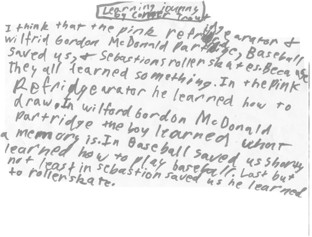
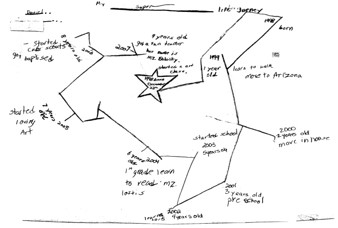
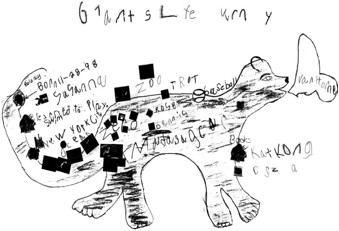
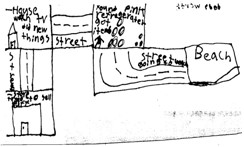









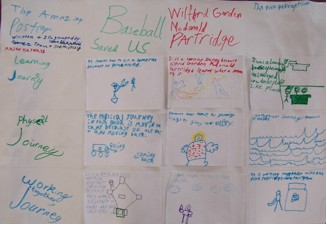
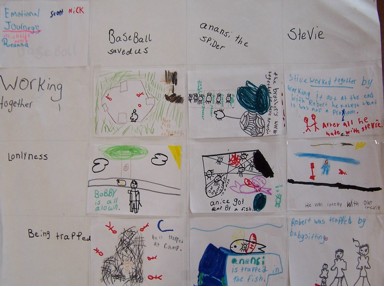
One thought on “WOW Stories: Connections from the Classroom”